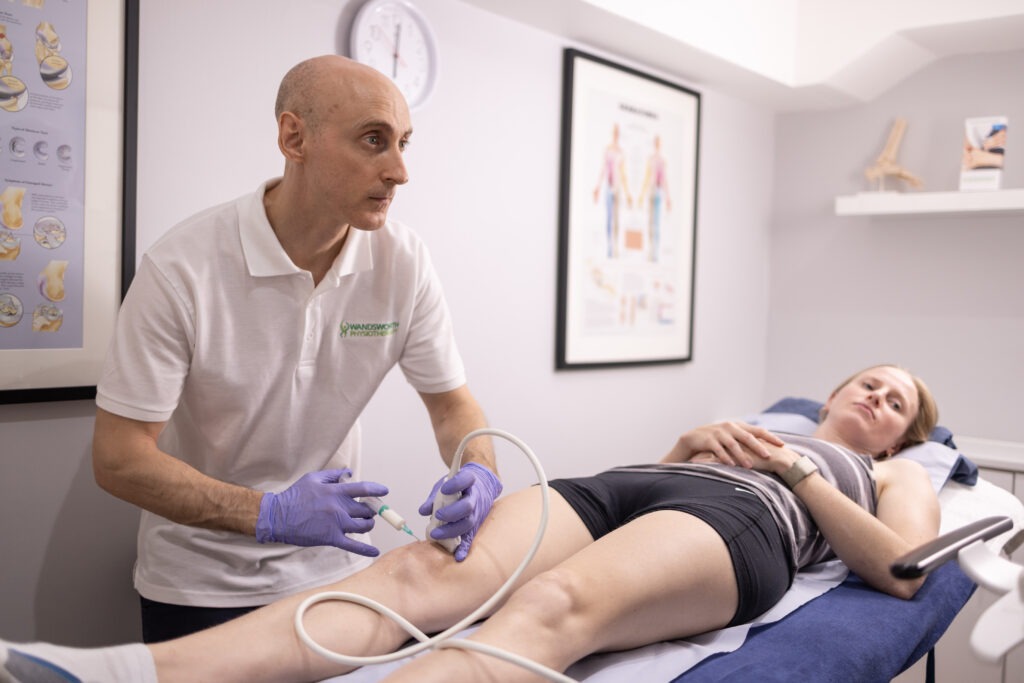Musculoskeletal conditions such as osteoarthritis, frozen shoulder, and tendinopathies can cause debilitating pain, restrict mobility, and significantly impact quality of life. For patients who have not responded fully to first-line treatments such as medication, exercise, and physiotherapy, injections can play an important role in reducing pain and improving function.
But when it comes to joint injections, there are two main techniques: landmark-guided injections (LGI) and ultrasound-guided injections (USGI). Both have been used widely in clinical practice, but the evidence increasingly shows that ultrasound guidance offers superior accuracy, safety, and patient outcomes.
In this article, we’ll compare landmark-guided and ultrasound-guided injections, and explain why ultrasound-guided injections at Wandsworth Physiotherapy are now considered the preferred option for managing pain and restoring movement.

What Are Landmark-Guided Injections?
Landmark-guided injections rely on a clinician’s knowledge of anatomy and palpation skills to estimate the correct site for injection. The needle is inserted using bony or soft tissue landmarks as reference points.
This technique has been widely used for decades in physiotherapy and musculoskeletal medicine. While effective in many cases, LGIs have several limitations:
- Reduced accuracy – Studies suggest accuracy rates vary widely, with some injections missing the joint space altogether.
- Variable effectiveness – Pain relief and functional improvements depend heavily on the skill and experience of the clinician.
- Limited safety – Without imaging, there is a higher risk of injecting into surrounding soft tissue, blood vessels, or nerves.
Landmark-guided injections remain in use, particularly in busy NHS settings, but patients are increasingly seeking more precise approaches.
What Are Ultrasound-Guided Injections?
Ultrasound-guided injections (USGI) use real-time imaging to ensure the needle is placed directly into the intended joint or soft tissue structure. At Wandsworth Physiotherapy, our expert clinicians use portable ultrasound scanners to provide this advanced level of precision.
With USGI, the clinician can:
- Visualise the joint or tendon in real time
- Directly monitor the needle pathway
- Confirm accurate delivery of medication
This means patients benefit from more effective, safer, and longer-lasting results.
Comparing Accuracy
Accuracy is perhaps the most important distinction between the two techniques.
- Landmark-guided injections can be inaccurate, particularly in joints that are deep, irregular, or affected by swelling and deformity. For example, studies have shown that landmark-guided knee injections may only reach the joint space around 70% of the time.
- Ultrasound-guided injections, by contrast, have accuracy rates above 95%. This ensures the medication reaches exactly where it is needed — reducing inflammation, relieving pain, and improving movement.
At Wandsworth Physiotherapy, our clinicians perform all injections under ultrasound guidance, giving patients peace of mind that treatment will be delivered with maximum precision.
Comparing Safety of Ultrasound Guided Injections
Safety is another crucial factor when deciding between LGI and USGI.
- Landmark-guided injections carry a slightly higher risk of complications, such as bleeding, infection, or accidental injury to surrounding structures. While these risks remain low overall, the blind technique leaves more room for error.
- Ultrasound-guided injections are far safer, as the clinician can see and avoid blood vessels, nerves, and sensitive tissues in real time. This reduces the likelihood of complications and provides reassurance for both clinician and patient.
Comparing Patient Outcomes
The ultimate goal of any injection is to reduce pain, restore mobility, and improve quality of life.
- With landmark-guided injections, results can be inconsistent. If medication does not reach the target structure, patients may experience limited or short-lived relief.
- With ultrasound-guided injections, outcomes are consistently better. Patients typically report faster pain relief, greater improvements in mobility, and longer-lasting benefits.
Conditions Treated with Ultrasound-Guided Injections
At Wandsworth Physiotherapy, we use ultrasound-guided injections to treat a wide range of musculoskeletal conditions, including:
- Osteoarthritis (knee, hip, shoulder)
- Frozen shoulder like our shoulder clinic
- Shoulder impingement and rotator cuff injuries
- Tendinopathies (tennis elbow, Achilles tendinopathy, patellar tendinopathy)
- Plantar fasciitis
Learn more about our ultrasound-guided injection services here.

Why Choose Ultrasound-Guided Injections at Wandsworth Physiotherapy?
At Wandsworth Physiotherapy, we are committed to delivering the highest standard of care. When you book an ultrasound-guided injection with us, you can expect:
- Expert clinicians: highly trained in musculoskeletal assessment and injection therapy
- Cutting-edge technology: high frequency ultrasound probes for precise targeting
- Personalised treatment plans: injections combined with tailored physiotherapy and rehabilitation
- Patient-centred care: shared decision-making and follow-up support
By combining injections with evidence-based physiotherapy, we help our patients achieve the best possible outcomes – reducing pain, improving mobility, and avoiding or delaying the need for surgery.
The Future of Injection Therapy in Physiotherapy
The evolution from landmark-guided to ultrasound-guided injections reflects a broader trend in physiotherapy: the integration of technology to improve accuracy, safety, and patient outcomes. Just as shockwave therapy, blood flow restriction training, and sports science technology have transformed rehabilitation, ultrasound guidance is now setting the standard for injection therapy.
At Wandsworth Physiotherapy, we believe ultrasound-guided injections represent the future of musculoskeletal care, a future where patients can be confident that their treatment is delivered safely, accurately, and effectively.
Conclusion
While landmark-guided injections have played an important role in musculoskeletal medicine, they are limited by variable accuracy and outcomes. Ultrasound-guided injections, on the other hand, offer clear advantages in precision, safety, and patient satisfaction.
If you are struggling with persistent joint or tendon pain and conservative treatments haven’t provided enough relief, an ultrasound-guided injection in Wandsworth could be the solution to help you move with confidence again.
Frequently Asked Questions (FAQs)
1. What is the difference between a landmark-guided and an ultrasound-guided injection?
Landmark-guided injections rely on anatomical landmarks to estimate where the needle should go, which can sometimes be inaccurate. Ultrasound-guided injections, offered at Wandsworth Physiotherapy near Clapham Junction and Battersea, use live imaging to ensure the needle and medication are delivered directly to the right area, making them far more precise.
2. Are ultrasound-guided injections painful?
Most patients in Wandsworth, Battersea and Clapham report only mild discomfort during an ultrasound-guided injection. Because our clinicians use real-time ultrasound to guide the needle, the procedure is usually quick, accurate, and less uncomfortable than traditional landmark-guided injections.
3. How long do the effects of an ultrasound-guided injection last?
Relief can last from several weeks to months, depending on your condition and the type of injection used. At Wandsworth Physiotherapy, many patients combine injections with tailored physiotherapy to maximise and prolong results. We see excellent outcomes for conditions like knee arthritis, frozen shoulder and tendon pain across South West London.
4. Are ultrasound-guided injections safe?
Yes. Ultrasound-guided injections are very safe, as the imaging allows the clinician to avoid nerves, blood vessels, and other sensitive structures. At our clinic in Wandsworth, close to Clapham Junction and Battersea, this technology reduces risks compared to landmark-guided injections and gives patients peace of mind.
5. Who is a good candidate for an ultrasound-guided injection in Wandsworth?
If you live in Wandsworth, Battersea, Clapham or South West London and have persistent joint, tendon, or soft tissue pain that hasn’t improved with exercise, medication, or physiotherapy, you may benefit from an ultrasound-guided injection. Our team regularly treats conditions such as osteoarthritis, frozen shoulder, rotator cuff injuries and plantar fasciitis.